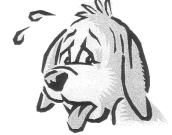SEPARATION ANXIETY
 Separation anxiety is just one of a wide variety of behavior disorders which can affect dogs in general. These include obsessive-compulsive disorders, various phobias, panic attacks, ect. These disorders are probably not new conditions, but therapy, behavior modification techniques, and training methods to treat them. Separation anxiety appears to one of the most common behavior disorders that veterinarians encounter. Symptoms of separation anxiety commonly occur in the owners absence and include:
Separation anxiety is just one of a wide variety of behavior disorders which can affect dogs in general. These include obsessive-compulsive disorders, various phobias, panic attacks, ect. These disorders are probably not new conditions, but therapy, behavior modification techniques, and training methods to treat them. Separation anxiety appears to one of the most common behavior disorders that veterinarians encounter. Symptoms of separation anxiety commonly occur in the owners absence and include:
- Elimination- urinating and/or defecating indoors when owner is gone.
- Destruction- chewing woodwork, furniture, carpeting, ect, when the owner is not in the house. This also includes clawing or digging floors, walls and doors. Damage also can occur to windows, drapes and blinds.
- Vocalization- barking, whining, crying in the owners absence.
- Other signs- including loss of appetite, depression, diarrhea, vomiting, excessive licking, increased salivation, decreased activity, pacing, circling and trembling.
- “Velcro dogs”- they stay physically close to their owners at all times. These dogs beg for attention and greet their owners over-enthusiastically. Treatment involves the combination of behavior modification with or without drug therapy. Behavior modification consists of abortion of inappropriate behavior, teaching new behaviors and general relaxation techniques.
BEHAVIOR MODIFICATION
Teach the dog not be anxious when left alone. This is done by utilizing the “sit”, “stay” and “relax” commands while the owner does a variety of routine chores around the house- some of which may upset the dog (vacuum the house). The dog should eventually be able to do these behaviors with out reacting adversely- in the house, outside the house, and for all the family members. Next, teach the dog to be left alone for gradually increasing periods of time. Here consider taking the dog to work, hiring a pet sitter, or kenneling the dog during the day. In addition, the dog must respond to programs designed to support and encourage deferential behavior throughout the day i.e. less “babying” behavior. For example, the owner should only interact with the pet only at the owner’s initiative and when the dog is relaxed. Obedience training would also be useful here as well. All these things foster independence in the dog.
Crate the dog or isolate it in a safe room- an area where the dog feels safe and secure. Usually this area is brightly lit with a TV or radio on. Also have a signal that will tell the dog 15-20 minutes before you return that you’ll be coming back ( a light on a timer, ect.). Some dogs do better outside or if they can see out side.
Identify cues that make your dog realize you are about to leave. These cues may include putting on make up, dressing in work clothes, picking up your car keys, making lunch, ect. Try to vary the cues by wearing different clothes, leave by a different door, water the plants before leaving- anything to change the pattern so the dog can’t know when you are leaving the house. This will help the dog to become indifferent to departure cues.
MEDICATION
Most of the medications for separation anxiety are tricyclic antidepressants (TCA) which have selective serotonin reuptake inhibitor (SSRI) activity. They affect two brain neurotransmitters, serotonin and norepinephrine, and increase their concentration in the brain. The end result is a decrease in anxiety and an increase in learning ability. The only licensed medication for the treatment of separation anxiety at this time in Clomicalm® (clomipramine). Medication should never be used by itself- the drugs should always be combined with behavior modification.
Using the above therapies together often decreases the symptoms or eliminates them altogether. Often the drug therapy can be dropped and behavior modification alone can maintain control of the condition. To say that a dog is “cured” is probably not correct – one has to think in the terms of control.